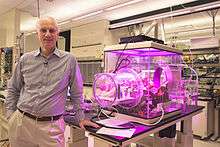Klaus Lackner
| Klaus S. Lackner | |
|---|---|
 | |
| Alma mater |
Heidelberg University (Ph.D. 1978, Diplom 1976)[1] |
| Known for | Carbon Dioxide Capture and Sequestration |
| Scientific career | |
| Fields | Theoretical Physics, Environmental Engineering |
| Institutions | Los Alamos National Laboratory, Columbia University, Arizona State University |
Klaus S. Lackner is the director of the Center for Negative Carbon Emissions (CNCE) and a professor in School of Sustainable Engineering and the Built Environment at Arizona State University. He is a pioneer in carbon management and is the first to suggest capturing carbon dioxide from air in the context of addressing climate change.[2][3] His current work includes the demonstrating and improving passive methods to remove carbon dioxide from the atmosphere, integrating air capture technology with applications for using carbon dioxide, exploring safe and permanent disposal options for carbon dioxide, and identifying opportunities for automation and scaling. His publications have been cited 5842 times as of November 12, 2015.[4] His h-index is 31.
Previously, he was the director of the Lenfest Center for Sustainable Energy at the Earth Institute and Faculty in the Earth and Environmental Engineering department at Columbia University from 2001 - 2014. He, along with CNCE executive director, Allen Wright, co-founded one of the first privately held air capture companies Global Research Technologies (GRT) in Tucson, AZ where they demonstrated the moisture swing.[5] Prior to his academic work he held appointments at the theoretical division of Los Alamos National Laboratory for nearly 17 years. His idea of the self-replicating machines along with his colleague, Christopher Wendt, was featured by Discover Magazine in 1995 as “One of the 7 Ideas that can Change the World.”
Articles
- Lackner, Klaus S. (Nov 2016). "The Effect of Moisture on the Hydrolysis of Basic Salts". Chemistry: A European Journal. 22: 18326–18330. doi:10.1002/chem.201603701.
- Lackner, Klaus S. (Feb 2016). "Capture CO2 from Ambient Air Using Nanoconfined Ion Hydration". Angewandte Chemie. 55 (12): 4026–4029. doi:10.1002/anie.201507846.
- Lackner, Klaus S. (June 2012). "The urgency of the development of CO2 capture from ambient air". Proceedings of the National Academy of Sciences of the United States of America. 109 (33): 13156–13162. doi:10.1073/pnas.1108765109. PMC 3421162. PMID 22843674.
- — (June 2010). "Washing carbon out of the air". Scientific American. 302 (6): 48–53. doi:10.1038/scientificamerican0610-66.
- Lackner, Klaus S. (September 2009). "Capture of carbon dioxide from ambient air". European Physical Journal ST. 176 (1): 93–106. doi:10.1140/epjst/e2009-01150-3.
References
- ↑ "Klaus Lackner, Ph.D. - Center for Negative Carbon Emissions". Arizona State University. Retrieved 2016-12-06.
- ↑ http://wordpress.ei.columbia.edu/lenfest/files/2012/11/Carbon-dioxide-extraction-from-air-is-it-an-option.pdf
- ↑ "Carbon dioxide disposal in carbonate minerals". Energy. 20: 1153–1170. doi:10.1016/0360-5442(95)00071-N.
- ↑ "Klaus Lackner - Google Scholar Citations". scholar.google.com. Retrieved 2015-11-12.
- ↑ "Moisture Swing Sorbent for Carbon Dioxide Capture from Ambient Air". Environmental Science. 45: 6670–6675. doi:10.1021/es201180v.